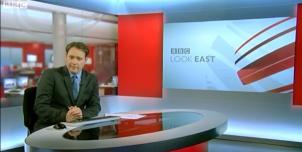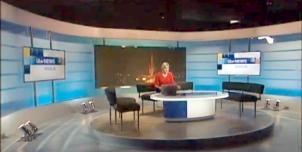Full Freeview on the Sandy Heath (Central Bedfordshire, England) transmitter
| Google Streetview | Google map | Bing map | Google Earth | 52.130,-0.242 or 52°7'47"N 0°14'33"W | SG19 2NH |
The symbol shows the location of the Sandy Heath (Central Bedfordshire, England) transmitter which serves 920,000 homes. The bright green areas shown where the signal from this transmitter is strong, dark green areas are poorer signals. Those parts shown in yellow may have interference on the same frequency from other masts.
_______
Digital television services are broadcast on a multiplexes (or Mux) where many stations occupy a single broadcast frequency, as shown below.
64QAM 8K 3/4 27.1Mb/s DVB-T MPEG2
H/V: aerial position (horizontal or vertical)
Which Freeview channels does the Sandy Heath transmitter broadcast?
If you have any kind of Freeview fault, follow this Freeview reset procedure first.Digital television services are broadcast on a multiplexes (or Mux) where many stations occupy a single broadcast frequency, as shown below.
64QAM 8K 3/4 27.1Mb/s DVB-T MPEG2
H/V: aerial position (horizontal or vertical)
Which BBC and ITV regional news can I watch from the Sandy Heath transmitter?

BBC Look East (West) 1.0m homes 3.7%
from Cambridge CB4 0WZ, 29km east-northeast (65°)
to BBC Cambridge region - 4 masts.
70% of BBC East (East) and BBC East (West) is shared output

ITV Anglia News 1.0m homes 3.7%
from Norwich NR1 3JG, 119km east-northeast (60°)
to ITV Anglia (West) region - 5 masts.
All of lunch, weekend and 80% evening news is shared with Anglia (East)
How will the Sandy Heath (Central Bedfordshire, England) transmission frequencies change over time?
| 1965-80s | 1984-97 | 1997-98 | 1998-2011 | 2011-13 | 12 Feb 2020 | ||||
| VHF | A K T | K T | K T | W T | W T | ||||
| C6 | ITVwaves | ||||||||
| C21 | C4waves | C4waves | C4waves | +BBCB | BBCB | ||||
| C24 | ITVwaves | ITVwaves | ITVwaves | D3+4 | D3+4 | ||||
| C27 | BBC2waves | BBC2waves | BBC2waves | BBCA | BBCA | ||||
| C31 | BBC1waves | BBC1waves | BBC1waves | ||||||
| C32 | com7 | ||||||||
| C33 | SDN | ||||||||
| C34 | com8 | ||||||||
| C35 | _local | ||||||||
| C36 | ArqA | ||||||||
| C39 | C5waves | C5waves | |||||||
| C43 | _local | ||||||||
| C48 | ArqB | ArqB | |||||||
| C51tv_off | SDN | ||||||||
| C52tv_off | ArqA | ||||||||
| C55tv_off | com7tv_off | ||||||||
| C56tv_off | COM8tv_off |
tv_off Being removed from Freeview (for 5G use) after November 2020 / June 2022 - more
Table shows multiplexes names see this article;
green background for transmission frequencies
Notes: + and - denote 166kHz offset; aerial group are shown as A B C/D E K W T
waves denotes analogue; digital switchover was 30 Mar 11 and 13 Apr 11.
How do the old analogue and currrent digital signal levels compare?
| Analogue 1-4 | 1000kW | |
| BBCA, D3+4, BBCB | (-7.4dB) 180kW | |
| SDN, ARQA, ARQB | (-7.7dB) 170kW | |
| com7 | (-13dB) 49.6kW | |
| com8 | (-13.1dB) 49.1kW | |
| Mux 1*, Mux 2*, Mux A*, Mux B*, Mux C*, Mux D* | (-17dB) 20kW | |
| Analogue 5 | (-20dB) 10kW |
Which companies have run the Channel 3 services in the Sandy Heath transmitter area
|
|
Wednesday, 1 January 2020
N
Nigel Johnson6:17 PM
Chris.SE: can we assume that scheduled moves of sandy heath channel allocations will be postponed if they conincide with unusual tropospheric radio propagation. Or are we to see messages to return at a time when the new frequency allocation will be blocked by interference.
One must wonder why the mobile phone companies are so keen to gain access to the higher Freeview TV frequencies, when they are subject to tropospheric RF ducting and scattering. Something that is going to become even more common due to the effects of global warming. Are the mobile phone operators not concerned about the disruption to their services when they attempt to use these frequencies in the mobile network backbone.
While the 5G is not directly responsible for the current free view interference, the sell off of the high frequencies in the band, must have had an impact on channel reuse distance planning, squeezing the free view channels closer together and thus reducing the available frequency reuse allocation distance, making co-channel interference more likely.
| link to this comment |
MikeP
8:10 PM
8:10 PM
Nigel Johnson:
It is highly unlikely that any engineering work will be postponed merely because of high pressure. There has been no change in the occurrance of temperature inversions related to 'Global Warming', and no increase is envisage in the future.
| link to this comment |
Thursday, 2 January 2020
C
Chris.SE3:24 AM
Nigel Johnson:
MikeP has already commented about tropospheric ducting. The only thing I would add is the tropospheric propagation conditions have been unusually strong for the time of year, even in summer we rarely see it as strong as this. Have you not noticed how the weather has been unusually warm? But also note that high pressure doesn't mean that temperature inversion also occurs.
In general, the only time engineering work gets postponed is where engineers need to climb/work on a mast, generally for antenna work and the weather is too bad to do so. No antenna work is likely to be needed as that was completed some considerable time ago.
There is only one change at Sandy Heath on the 12th Feb. when the SDN/COM4 multiplex moves from UHF C51 to C33, there are no power changes.
If you can do manual retunes/scans then you would probably get away with just doing so for C33 if conditions were such that you might lose other multiplexes.
It's also worth remembering that frequency allocation is subject to International Agreements primarily through the ITU. Then within that there is the European Radio Spectrum Policy and The European Conference of Postal and Telecommunications Administrations (CEPT) which has representatives from member countries. They carry out studies and other activities to harmonise the use of the radio spectrum in Europe, and have supporting bodies such as the ECC & ECO also the Radio Spectrum Committee (RSC). Recommendations/decisions are made and this usually results in EU level legislation. EU Member States who have representatives on the various bodies, manage the radio spectrum in their national responsibilities, in the case of the UK this is OFCOM.
The particular channel allocations, powers and radiation patterns at each transmitter results from studies and agreements with neighbouring countries to ensure little chance of interference with others transmitters using those particular frequencies. (I have so far only come across one case in the UK of what I would regard as a cock-up & that affects only a small area).
The squeezing of Freeview channels closer together, as you put it, is unlikely to have any significant effect. With the sort of propagation usually seen, interference usually comes from greater distances, eg. Yorkshire transmissions being received on the South Coast/Isle of Wight. Channel sharing of transmitters that sort of distance apart has always been the case. In the old B&W 405 line analogue days, on one occasion I recall receiving pictures from Eastern Europe ! and we used to talk about "Continental Interference". So that should give you some idea about the potential effects of such unusual propagation.
| link to this comment |
Wednesday, 12 February 2020
N
Nigel Johnson8:29 PM
After the refund of Sandy Heath today, all channels report stronger signals and better quality( 10 out of 10 for both signal and quality), apart from channel 35 which is signal 6 out of 10 and quality of 4 out of 10. Most of the time this is unwatchable.
My location is in the Wisbech area.
| link to this comment |
C
Chris.SE9:17 PM
Nigel Johnson:
Not certain where you are getting C35 from, but it is not transmitted from Sandy Heath.
Sandy Heaths channels are C27, C24, C21, C33, C36, C48, C55, C56 in the order PSBs1-3, COMs4-8.
If C35 is as I suspect a Local multiplex from Cambridge from the Madingley Light transmitter, then you are doing quite well to pick it up. There was a slight power increase on that Local multiplex last week, but it is still low power at 3.2kW.
| link to this comment |
Thursday, 13 February 2020
N
Nigel Johnson4:28 PM
Chris.SE: I was surprised to see C35. I assumed there was an error on the list of sandy heath channel frequencies.
I am interested in C35 because it is transmitting services not on the other sandy channels, such as Sony movies classic.
By the way in my last post, auto spell corrector managed to turn "retune" into "refund". Maybe this is appreciate, comment refering to the TV license and the inability to access all the Freeview channel services..
| link to this comment |
C
Chris.SE7:51 PM
Nigel Johnson:
For a list of which channels are on which mux, see Channel listings | Freeview
| link to this comment |
Thursday, 20 February 2020
F
Freddie Archer4:57 PM
I pickup C35 from Madingly, very well in Brandon, Suffolk.
An unexpected extra!!
| link to this comment |
Sunday, 29 March 2020
M
margaret swannack2:16 PM
Wellingborough
why in this troubled time can you not bring back what used to be channells 51 & 52. NN9 5yt
| link to this comment |
margaret's: mapM's Freeview map terrainM's terrain plot wavesM's frequency data M's Freeview Detailed Coverage
S
StevensOnln14:56 PM
margaret swannack: If you're referring to the former True channels, which were rebranded as Sony, the reduction in coverage was a decision taken by the broadcaster. It is only Sony who can decide to increase the coverage of their channels again, which would require paying for capacity on a multiplex with wider coverage (if there is even any space available) and technical changes which would require many viewers to retune in order to receive the channels (such changes are unlikely to be made during the current public health crisis). In short, the chances of that happening are probably very low right now.
| link to this comment |
Select more comments
Your comment please!




